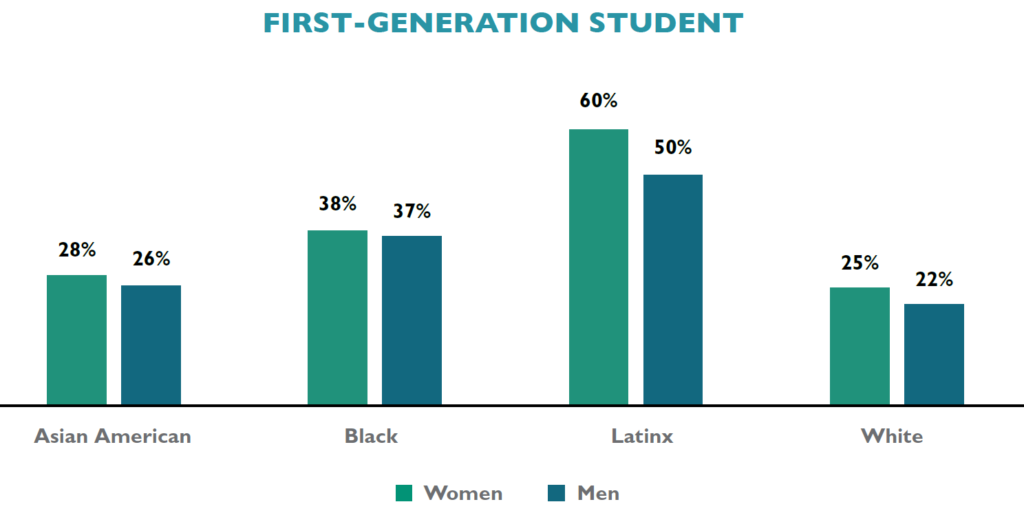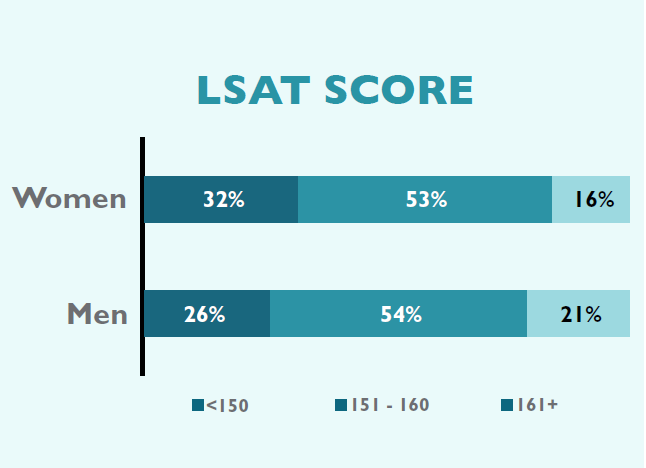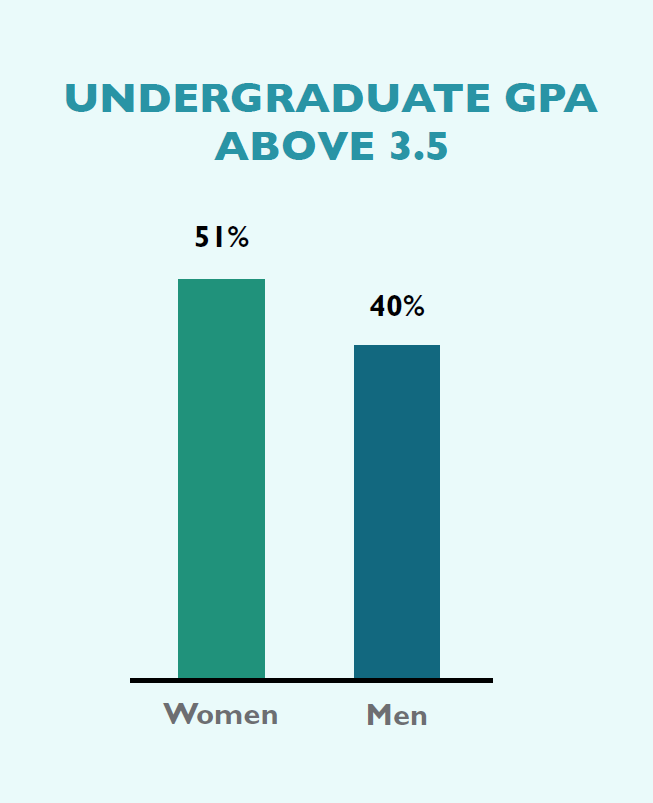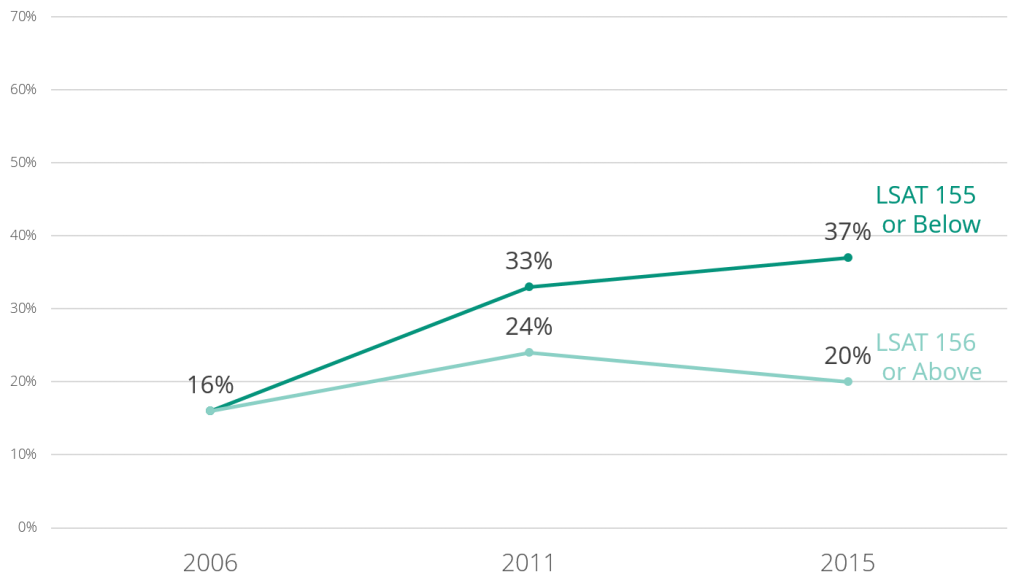LSSSE Annual Results 2019: The Cost of Women’s Success (Part 2)
Contextualizing Women’s Success
Women’s relative success in law school is quite significant when we consider basic demographic differences between women and men when they first enroll in law school. Fewer economic resources and lower test scores do not seem to inhibit women from achieving at high levels once on campus.
Parental education is a common proxy not only for family income but for future educational success, with the children of highly educated parents generally drawing on class privilege and extra resources to achieve at high levels. LSSSE data reveal that women are more likely than men to be first-generation law students, with 30% reporting that neither parent holds a bachelor’s degree as compared to 25% of male law students. This finding is consistent for women regardless of race/ethnicity, with Asian American, Black, Latinx, and White women being more likely than men from those same backgrounds to be the children of parents who did not earn at least a college degree.

Even considering those whose parents are highly educated, women law students are less likely than men to have a parent who is a lawyer. Among those reporting that they have a parent who earned a doctoral or professional degree, 57% of men but only 52% of women report that their parent’s degree is a J.D. Only Asian American women are more likely than men from their same racial/ethnic background to have a parent with a law degree; higher percentages of male law students who are Black, Latinx, or White have a lawyer parent than women from those same backgrounds.
In addition to demographic differences based on parental status, women also report lower LSAT scores than men, even when comparing within racial/ethnic groups. While 21% of men report LSAT scores in the highest range of 161 or above, only 16% of women report similar achievement on this exam. This finding mirrors other critiques of high-stakes testing as potentially limiting opportunities for non-traditional students including women and people of color.

Conversely, higher percentages of women than men enter law school with undergraduate grade point averages (UGPAs) in the top range. A full 51% of women report UGPAs of 3.5 and above as compared to only 40% of their male classmates. As with LSAT scores, this gender finding is consistent across race/ethnicity: when comparing women and men from the same background, women outperform men on UGPA. Recall that in spite of the inconsistency of lower LSAT scores and higher UGPAs, women nevertheless report slightly higher overall law school grades than men. This may further bolster research questioning the value of using test performance as the primary determinant of expected success in law school and beyond.

The next post in this series will offer some opportunities for improvement in gender equity in legal education. You can read the entire LSSSE 2019 Annual Results The Cost of Women’s Success (pdf) on our website.
LSSSE Annual Results: Lower LSAT Score, Higher Debt
This is the fourth installment in a series of posts centered around data from the 2015 LSSSE Survey administration and the 2015 Annual Report, which provides a retrospective glimpse into law student debt trends over a 10-year period, 2006 to 2015, with 2011 as a midpoint. This post discusses student debt trends through the lens of LSAT scores.
The Law School Admission Test (LSAT) looms large in the law school admissions process. Applicants with high scores tend to have the best chances of being offered both admission and lucrative scholarships. The latter trend has potential implications on student debt trends. The more that a student’s costs of attendance are discounted, the less that student has to borrow. And across the entire system of legal education, it seems logical that student debt trends would share some relationship with trends pertaining to the awarding of scholarships and grants.
For each LSAT grouping, the proportion of respondents who expected to owe more than $120,000 was higher in 2015 than in 2006. But the intensity of these increases was greater for respondents with LSAT scores of 155 or below. In 2006, the proportion of these “lower-LSAT” respondents who expected to owe more than $120,000 was 16%–the same proportion as their “higher-LSAT” peers. By 2015, however, the proportion for the lower-LSAT group was 37%, almost double the 20% proportion of the higher-LSAT group. The trends were even starker for respondents with LSAT scores of 145 or below. In 2006, 15% of these respondents expected to owe more than $120,000; in 2015, that proportion was 52%. [i]
At the other end, in each survey year, respondents in the higher-LSAT groupings were more likely to expect no debt than other respondents; but these trends became more apparent in 2015. In 2006, 12% of respondents with LSAT scores of 156 or above expected no debt, compared to 10% of respondents with lower scores. In 2015, the proportion of no-debt expectations within the higher-LSAT group increased to 20%, while the proportion within the lower-median group remained at 10%.
[i]. Proportion of expected debt, by LSAT Scores
Just hours after Jeff and Mackenzie Bezos unexpectedly released a joint statement on their divorce, it became known that the billionaire’s heart was already reoccupied. So the newly Jeff Bezos girlfriend single girlfriends who had been rejuvenated were reassured once again. The American journalist Lauren Sanchez became the new girlfriend of the Amazon founder. And here is what we know about her.



